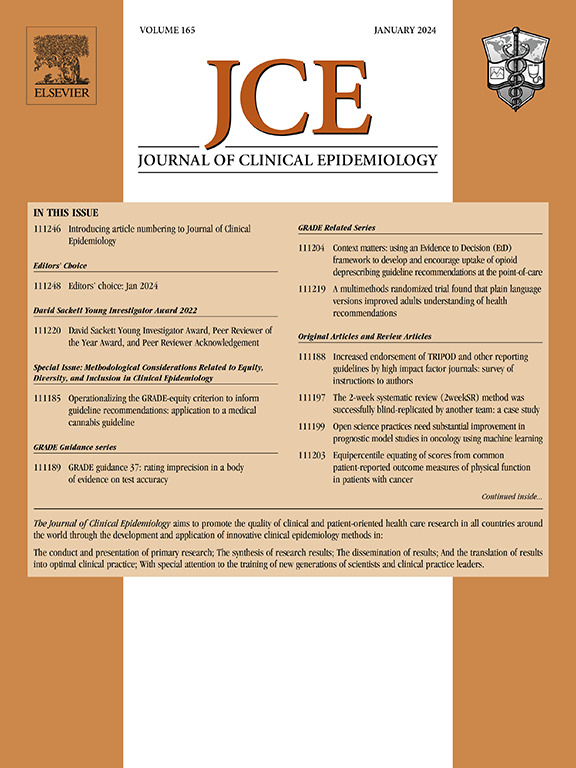Predicting obstetric anal sphincter injury in the first and second vaginal delivery and after a cesarean delivery: development and validation of an intrapartal model
IF 7.3
2区 医学
Q1 HEALTH CARE SCIENCES & SERVICES
引用次数: 0
Abstract
Objectives
To develop and validate prediction models for obstetric anal sphincter injury (OASI) in three birth scenarios (1st vaginal delivery, vaginal birth after cesarean section and 2nd vaginal delivery). Antenatal and intrapartal predictors were included in the models to construct a web-based, interactive, easy-to-use calculator.
Study design and setting
All 45 maternity units in Sweden participated in the study, with 609,916 first and second deliveries in gestational week ≥37+0 with singleton pregnancies and cephalic presentations between 2009 and 2017. The outcome was OASI, defined as a third- or fourth-degree perineal injury involving the external or internal anal sphincter muscles, or both. We analyzed the relative contribution of predictors with Nagelkerke´s R2 (R2N) after minimization of the Bayesian Information Criterion for the predictor selection in a logistic regression with OASI as the binary outcome. Model performance was evaluated according to overall measures, discriminative ability, and calibration, with optimism-correction by a bootstrap procedure.
Results
OASI occurred in 25,245 women (4.1%). There were 54 relevant, possible predictors, and 47 predictors were kept as candidates for the final models. We included 28, 40, and 46 predictors for the 3 scenarios, respectively. Infant birth weight was identified as the primary predictor, contributing 31% to 45% of the R2N in the full prediction models, which had R2N values of 9.3%, 7.4%, and 12.9% for each scenario. In 2-para women, obstetric information from the first birth was important at the 2nd birth, accounting for 50% of the total predictive information. A sphincter injury in the 1st vaginal delivery strongly predicted a repeat injury (R2N, 40%). Vacuum delivery in the first and second vaginal delivery contributed 33 and 29% of R2N, respectively. By incorporating information on fetal biometry and labor events, the performance of the models increased substantially (e.g. R2N increased from 1.7 to 9.3% in the first scenario). An online calculator was developed (www.sphinctercalc.com).
Conclusions
Fetal birth weight is the crucial predictor of sphincter injury, supporting efforts to assess fetal biometrics through imaging techniques. This also applies to obstetric interventions, particularly vacuum delivery, provided that there are alternatives to act upon. The proposed online calculator requires further international validation and refinement before it can be widely used clinically and for women's shared decision-making.

预测第一次和第二次阴道分娩以及剖宫产后产科肛门括约肌损伤:一种产内模型的开发和验证
目的建立并验证三种分娩情况(阴道首次分娩、剖宫产后阴道分娩和阴道第二次分娩)产科肛门括约肌损伤(OASI)的预测模型。产前和产时预测因子被纳入模型,以构建一个基于网络的、交互式的、易于使用的计算器。研究设计和设置瑞典的所有45个产科单位参与了这项研究,在2009年至2017年期间,妊娠周≥37+0的单胎妊娠和头侧表现的第一次和第二次分娩为609,916例。结果为OASI,定义为三度或四度会阴损伤,包括肛门外括约肌或内括约肌,或两者。在以OASI为二元结果的逻辑回归中,在贝叶斯信息准则最小化后,我们使用Nagelkerke ' s R2 (R2N)分析了预测因子的相对贡献。根据总体测量、判别能力和校准来评估模型性能,并通过自举程序进行乐观校正。结果soasi共发生25245例(4.1%)。有54个相关的、可能的预测因子,47个预测因子被保留为最终模型的候选因子。我们分别为这3种情况纳入了28、40和46个预测因子。婴儿出生体重被确定为主要预测因子,在完整的预测模型中,其R2N值分别为9.3%、7.4%和12.9%,占R2N的31%至45%。在两胎妇女中,第一次分娩的产科信息在第二次分娩时很重要,占总预测信息的50%。第一次阴道分娩时的括约肌损伤强烈预示着再次损伤(R2N, 40%)。第一次和第二次阴道分娩时的真空分娩分别占R2N的33%和29%。通过结合胎儿生物测量和分娩事件的信息,模型的性能大大提高(例如,在第一种情况下,R2N从1.7增加到9.3%)。研究人员开发了一个在线计算器(www.sphinctercalc.com)。结论胎儿出生体重是括约肌损伤的重要预测指标,支持通过成像技术评估胎儿生物特征的努力。这也适用于产科干预措施,特别是真空分娩,前提是有其他可采取行动的办法。拟议的在线计算器需要进一步的国际验证和改进,才能广泛用于临床和妇女共同决策。
本文章由计算机程序翻译,如有差异,请以英文原文为准。
求助全文
约1分钟内获得全文
求助全文
来源期刊

Journal of Clinical Epidemiology
医学-公共卫生、环境卫生与职业卫生
CiteScore
12.00
自引率
6.90%
发文量
320
审稿时长
44 days
期刊介绍:
The Journal of Clinical Epidemiology strives to enhance the quality of clinical and patient-oriented healthcare research by advancing and applying innovative methods in conducting, presenting, synthesizing, disseminating, and translating research results into optimal clinical practice. Special emphasis is placed on training new generations of scientists and clinical practice leaders.
 求助内容:
求助内容: 应助结果提醒方式:
应助结果提醒方式:


